Great businesses see the future differently.
- Apple made CD’s redundant, and gave us 1,000 songs in our pocket
- Airbnb took travel, and made us all feel at home across globe
- Netflix made video rentals a thing of the past, and disrupted the Oscars
And now, Ugly Drinks is creating a new, healthier future for the $392 billion soft drinks industry, challenging giants like The Coca-Cola Company, PepsiCo and Red Bull head on.
From the outside, it may seem like a David v Goliath battle. But Ugly isn’t a plucky underdog. It’s a confident competitor with a different view of the world, and an unassailable belief in its mission.
Its product — a sugar, and sweetener free, natural flavoured sparkling water — launched in 2016, and has since built up strong sales, and a core of die-hard fans, on both sides of the Atlantic.
So, how has Ugly grown from a startup idea to challenging billion dollar brands?
Keep reading to uncover the four key steps Ugly has taken to build an industry-disrupting, global business in under five years…
1. Build a unique brand
Ugly believes that its audience is tired of ‘perfection’ and seeks a more sincere view of the world
Ugly’s founders, Hugh Thomas and Joe Benn, are no strangers to the drinks industry after working together at Vita Coco, and over the years, the pair had grown tired the way many soft drinks were marketed.
“The founders were sick of seeing brands selling sugar-filled products, made appealing by marketing that masked what you’re actually drinking,” Brittany Zenner, Ugly’s New York-based Social Media and Community Manager explained to me.
The belief that many brands are propped up by misleading marketing sparked the concept of the ‘Ugly Truth’, the brand’s mission to spread the truth about the world we live in.
So for consumers who are craving the truth, especially in the socio-political, fake news, world we’re in at the moment, we have positioned Ugly as a brand that tells every truth. — Hugh Thomas, Ugly Drinks co-founder
“Whatever newspaper you read, whatever news sources you’re getting, there is uncertainty on both sides, and I think that’s led to a lot of tension,” says Hugh Thomas, speaking to The Challenger Project. “So for consumers who are craving the truth, especially in the socio-political, fake news, world we’re in at the moment, we have positioned Ugly as a brand that tells every truth.”
Ugly doesn’t make any claims it can’t live up to: “No unobtainable lifestyles. No ridiculous promises. We’re not a dream, we’re a drink,” the brand stated in a 2018 advert.
Telling ‘every truth’ means that Ugly has to take a stand on topics outside of the drinks industry too. “The Ugly Truth started as a product message, but has broadened out to become about society. ” Zenner shared.
Ugly has partnered with Girl Up, a gender equality charity, to drive positive change and tackle global gender inequality. 1 cent of every drink purchased is donated to Girl Up’s leadership development program which trains teenage girls to take action for gender equality.
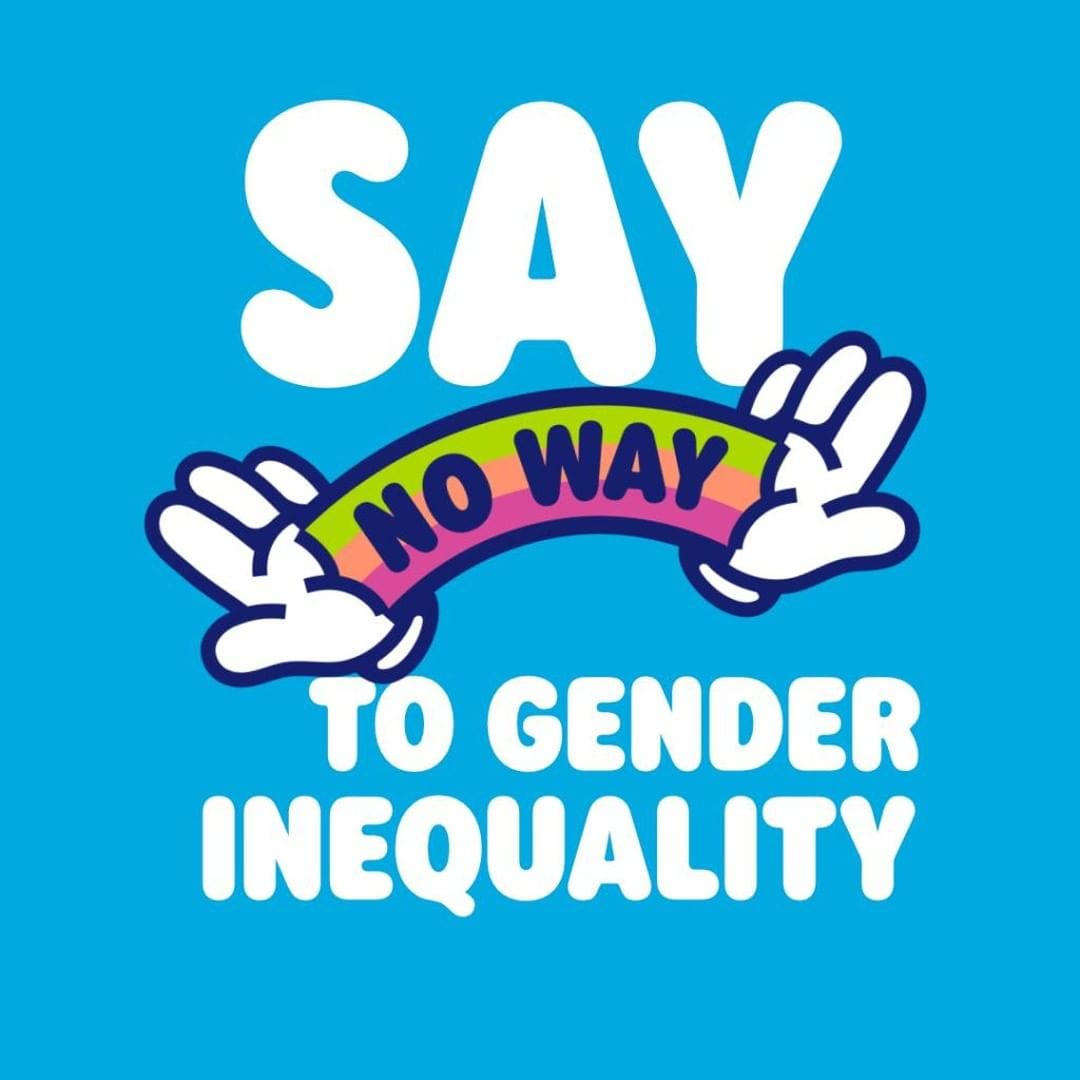
“The fact that we stand up for things can be divisive,” Zenner says. “Not every consumer supports the idea that brands should speak out about real life issues but we always try to stick to our values. Our mission, to expose The Ugly Truth, is something we all believe in passionately.”
2. Market where your customers are
Marketing to a young, rebellious audience means embracing social media channels for Ugly
Ugly’s customers are known as ‘GenZenials’ internally. “It’s a mixture of Gen-Z and millennials, 16-24 is our target audience range,” Zenner shares.
The brand seeks to connect with consumers who are socially engaged, and ‘a bit rebellious’. “But but not in a destructive way,” Zenner continues. “We’re more about positive rebellion, standing up for things and making changes in the world.”
Ugly, like many of its ‘GenZenail’ audience, was born in the age of social media, and when Ugly combined its unique brand message with social media channels like Instagram, it found a recipe for success.
“Social media has been an amazing tool for us to spread the Ugly word since launch,” says Thomas. “We are a high visual brand with a strong opinion and Instagram has been particularly successful for us in terms of building a following and engaging with our community.”
Ugly’s world view, and its focus on calling out the Ugly Truth guides all of its marketing from its tone of voice to the content it shares. “We call out marketing BS,” explains Zenner. “We’ll even make fun of ourselves if we’re using stock imagery or really polished videos. We poke fun at the brands that sell the dream and aspirational lifestyles. We’re about living at authentic life.”
But what does that look like in practice?
A great example of this is Ugly’s National Sibling’s Day post on Instagram. The playful copy, accompanying a professionally shot image, says: ‘In honor of #NationalSiblingsDay here’s a photo of two people who aren’t related enjoying some Ugly.’
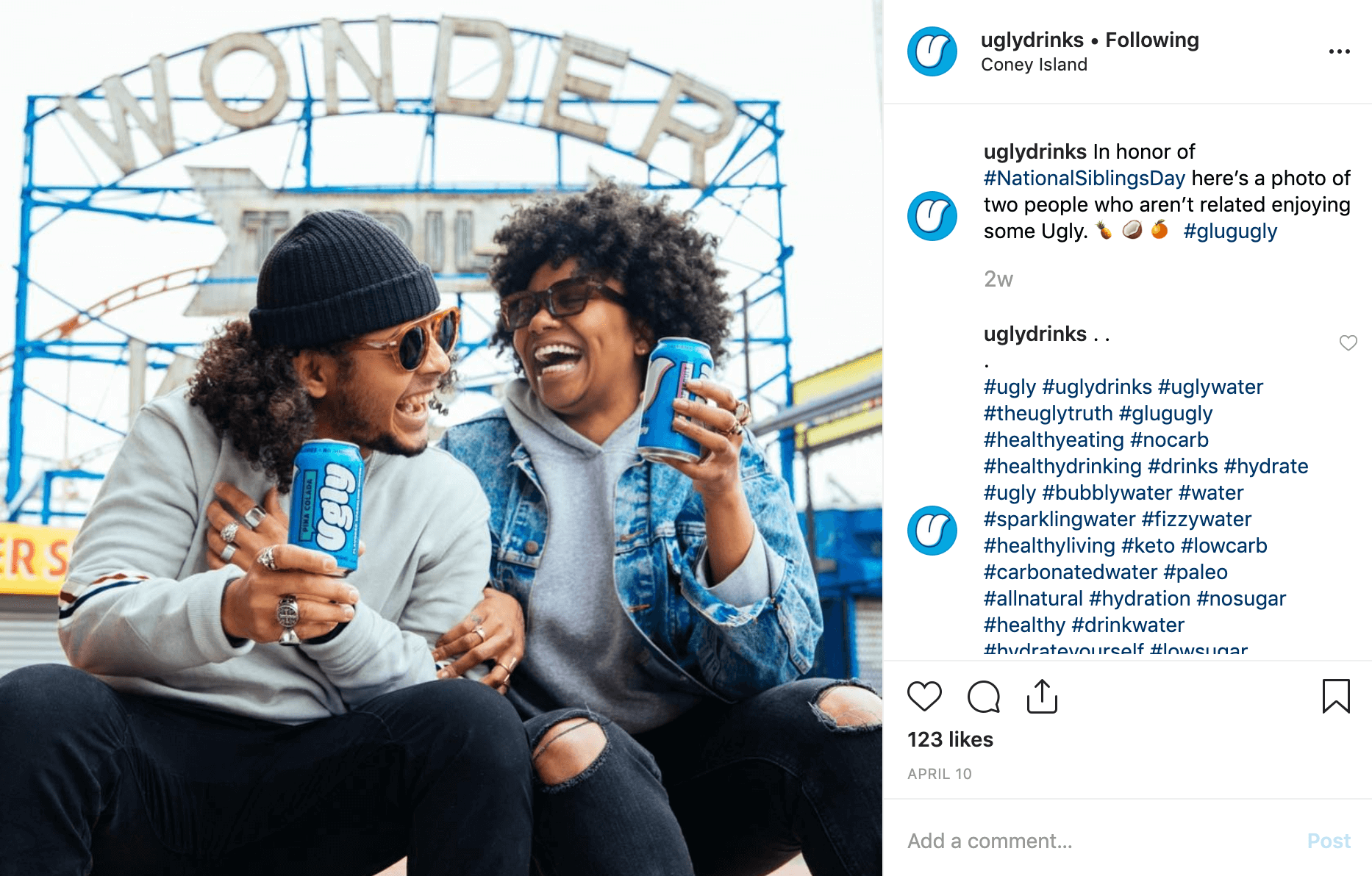
“We try not to take ourselves too seriously. Even when we make announcements or tackle serious subjects we try to be lighthearted,” says Zenner.
Ugly tries to steer clear from perfection, something that Zenner sees as growing trend in social media. “We went through this period of influencer saturation, where everything was hyper-polished and staged,” she explains. Consumers, Zenner believes, are bored and have switched off from this type of content, instead craving reality again. “We’re now bringing social media back to real-life,” she says.
The content Ugly creates is a mix of memes the team produces internally and professionally shot images, but Zenner believes that the amount of money you spend on content creation doesn’t tend to correlate with results.
“Honestly some of best performing content are the memes that we’ve created internally. It’s really low-fi but it’s the kind of stuff you would share with a friend,” she says. “We’ll take a popular meme format or just an image we think is funny, and add our own text onto it. When we put that up on our feed or story it tends to get better engagement that the content we’ve spent a bunch of money on.”
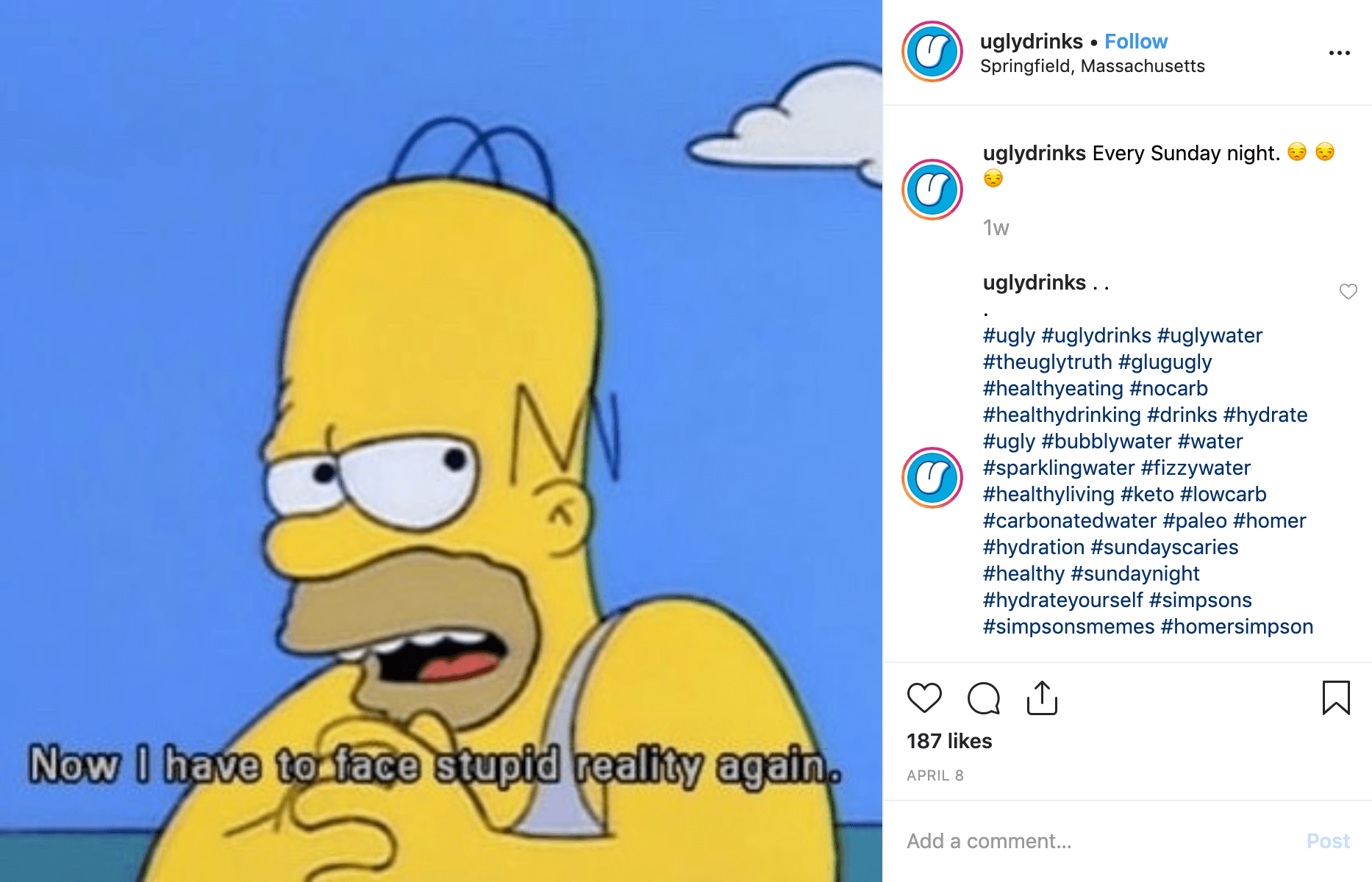
Pro Tip: When it comes to keeping on top of ever-changing internet and meme culture, the Ugly team has a Slack channel where they share content they stumble upon online. The team also keeps a close on on Reddit for the latest memes and trends.
3. Encourage your customers to become advocates
Thanks to Ugly’s customer-centric approach, people love to share their experiences with the brand on social media (and beyond)
Ugly has a passionate community of fans and customers it affectionately calls the ‘Ugly Mob’, and this community has been key to the growth of the business.
In the company’s early days, co-founder, Joe Benn, realized that building a community of brand advocates would help them to spread the world about their alternative, challenger brand.
“Our fans love to be seen with the cans,” Benn explained to a UK business site last year. “They buy our merch from the website and they stick our stickers everywhere! This word of mouth excitement around The Ugly Truth platform has been our best marketing by far.”

Another aspect of the community that Zenner says is hugely important to Ugly is user generated content on social media, with the brand often re-sharing social media posts from its audience to Instagram stories.
“We want to feel like we’re part of the community, not just speaking to the community,” Zenner says. “By re-sharing photos and videos of people enjoying Ugly and interacting with the brand it’s showing people authentically engaging with the brand [and product].”
“We care deeply about our community in both the U.K. and the U.S. and use social media to speak to consumers on a 1-1 basis as often as possible,” says Thomas. For Zenner, this means focusing on engagement on social media: “We try to at least like every comment and we always reply if we feel like there’s something to reply to. We like to show people that there is someone real on the end of the content we’re producing and that we’re seeing their messages.”
“To us, comments and DMs are even more important than likes, because they allow us to open up two-way communication with our audience.”
4. Listen to your customers
Speaking honestly and transparently with customers has helped Ugly to shape its business and build a brand people love
“We’ve built our entire brand at Ugly around being customer-centric and digitally native,” Zenner says.
Ugly makes key business decisions based on the feedback it receives from the its community, the ‘Ugly Mob’, and it actively seeks out this kind of feedback across channels — from social media to surveys and email.
One example of this is how Ugly sourced its three newest flavors — Watermelon, Piña Colada, and Pink Grapefruit. “All three of these were top voted options in surveys we sent out to our customers via email and surveys we posted on Instagram Stories and in our highly-engaged Facebook Group,” shares Zenner.
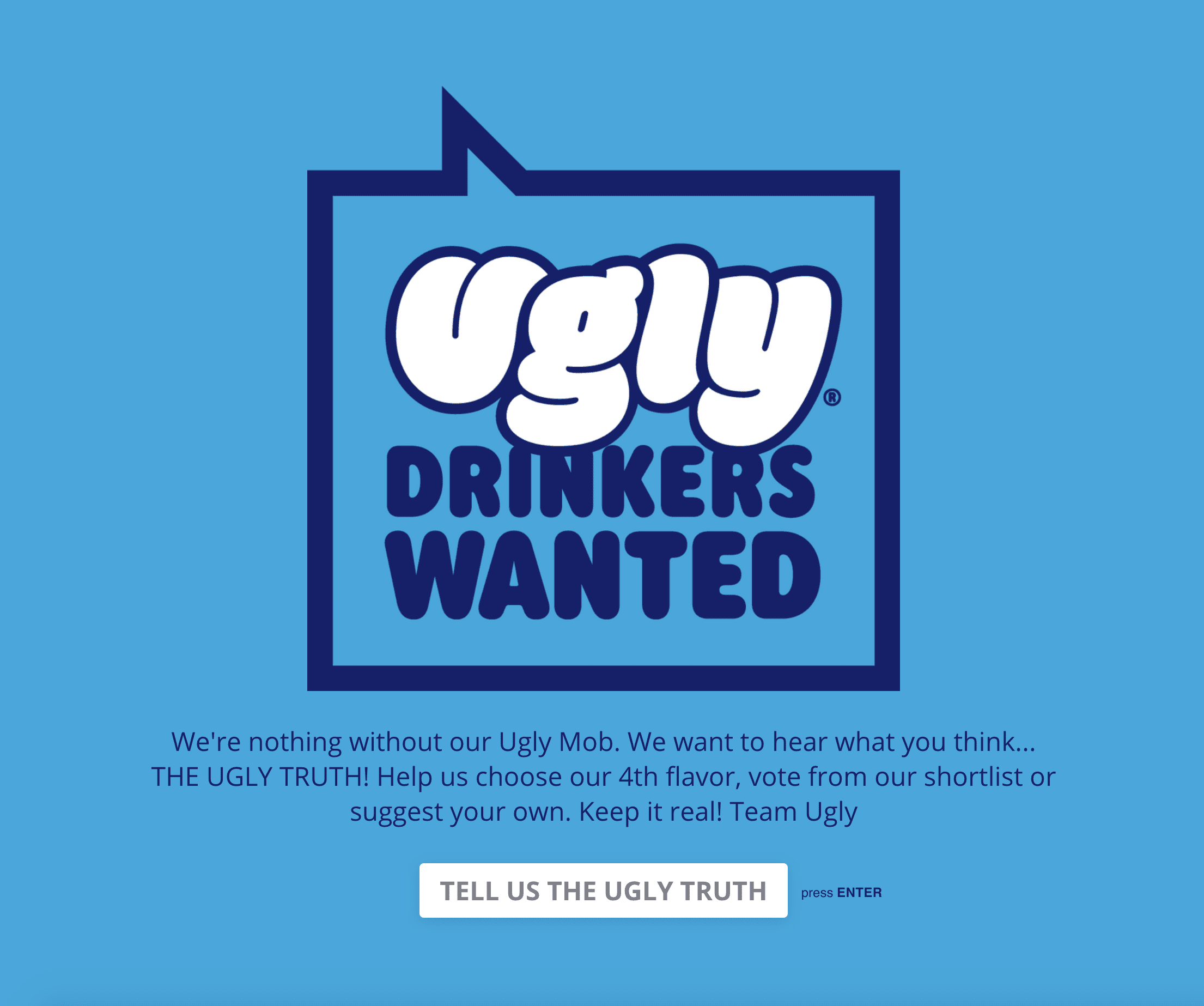
Ugly has also used surveys and customer feedback to make decisions about the merchandise it sells — yep, a drinks brand can also sell merch — and the content Zenner and the team at Ugly produce.
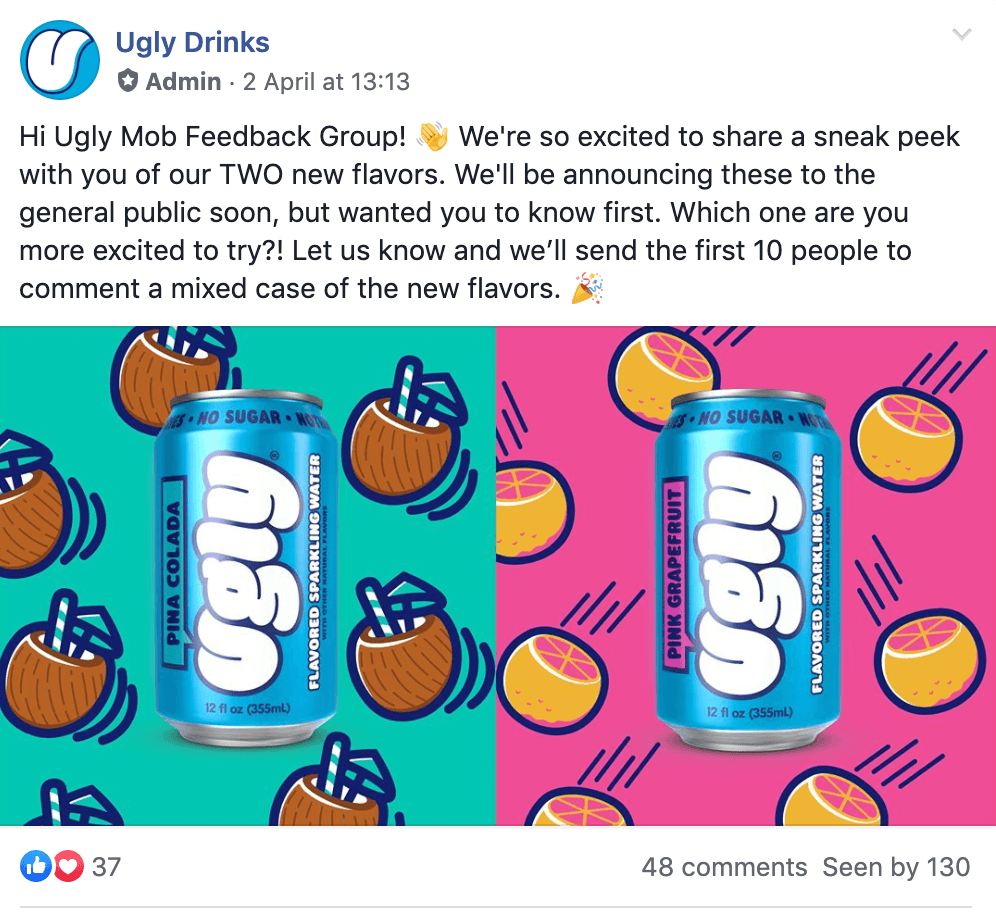
It’s also incredibly valuable for Ugly team members to take the time to speak with customers in detail, outside of email, surveys and social media. “I personally have gotten on the phone with a select group of customers to discuss what they love about Ugly and what they would like to see us improve,” says Zenner. “Those conversations have been invaluable and have opened our eyes to possibilities that structured surveys might miss.”
Creating the future of soft drinks for a more health conscious generation
A Nielsen study found the majority of consumers are trying to ditch sugar and embrace healthier lifestyles, and Ugly is a perfect fit for younger, more health conscious consumers.
Further to this, a poll conducted in conjunction with USA Today reporter Bruce Horowitz which surveyed more than 30,000 consumers in more than 60 nations, revealed that younger consumers are far more concerned about healthy living that older generations. The study found that the most health-centric group of consumers is Generation Z, part of Ugly’s GenZenial market.
With healthy and clean eating and drinking on the rise, Ugly is ideally positioned to continue its growth across the globe — especially if it sticks to the four tactics that have served it so well on its journey so far:
- Build a brand: Ugly believes that its audience is tired of ‘perfection’. It seeks a more authentic view of the world, and shares the ‘Ugly Truth’ about its industry and other global issues.
- Market where your customers are: Marketing to a ‘GenZenial’ audience means that Ugly embraces social media, and channels where its audience hangs out online.
- Encourage your customers to become advocates: Ugly’s customer-centric approach, encourages people to share their experiences with the brand on social media (and beyond).
- Listen to your customers: Speaking honestly and transparently with customers has helped Ugly to shape its business and build a brand people love.
It’ll be a few years before Ugly reaches the heights of the soft drinks industry Goliaths like The Coca-Cola Company and PepsiCo, but the journey will be fascinating to watch.
———-
You can follow Ugly on Instagram, Facebook and Twitter. A special thank you goes to Brittany Zenner, Social Media and Community Manager at Ugly, for sharing a ton of great insights for this story.
Try Buffer for free
190,000+ creators, small businesses, and marketers use Buffer to grow their audiences every month.



